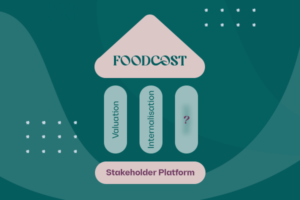The FOODCoST Internalisation Pillar
21 Nov. 2023
In the FOODCoST project, we will analyse options for the internalisation of externalities through True Cost Accounting (TCA) methods in both policy and business models – find out how in the article below, where we delve into the work that is being developed in the FOODCoST Internalisation Pillar!

The role of the food sector and its systems in ensuring both human and planetary health has been widely recognized globally, including in the European Union (EU), over the past decades. However, food and agricultural systems generate several environmental, social and health, and economic externalities.
Given the complexity of these systems and their far-reaching impacts in our society, Public Policy plays a crucial role in shaping their trajectory towards sustainability development. Similarly, in the Business Sector, it is crucial to find business models and strategy examples that can enable the internalisation of externalities in food and agriculture, through the introduction of innovations or mechanisms that change the relation of different actors in the value chain.
The FOODCoST Internalisation Pillar will work on assessing and evaluating models and strategies at the public and private level, in order to find the best cases of internalisation of externalities that can be applied in the food sector.
Public Policy
At the public policy level, we will work to map, describe, and assess public policies that promote or facilitate the internalisation of externalities within food value chains in the EU, both at national and regional levels. For our purposes, we define “internalisation” as any policy-induced change in costs and/or final product prices. This approach helps to examine public policies holistically and comprehensively, considering their intent, illustrating their economic mechanisms, and understanding both their intended and unintended effects.
We first collect the main public policies implemented in the European Union and in four countries. Then, based on a literature review, we identify their intended and unintended impacts on environmental, social, health, and economic externalities. We also describe, if possible, the theoretical economic mechanisms of internalisation. We further provide the methodological approach and descriptive results from the mapping of the selected public policies, pinpointing evidence gaps and recommending policy improvements in the food sector.
We will assess administrative-based instruments including regulation and other instruments such as coexistence measures, property rights, liability and compensation schemes, tradable permits and auctions, and quotas. Similarly, market-based instruments including taxes and charges, subsidies, and certification and labeling instruments will also be considered.
Business Models
At the business level, we aim to find Business Models (BM) and Business Strategy (BS) examples that enable the mitigation or internalisation of externalities.
But firstly, how can we define a Business Model? This is understood as how a company creates, delivers, and captures value for its customers and itself (Teece, 2010). It can be seen as a rationale for how a company earns money (Baden-Fuller and Mangematin, 2013) or creates value (non-monetary or not immediately monetised). It can also be defined as “a conceptual tool that contains a set of elements and their relationships and allows expressing the business logic of a specific firm” (Osterwalder, Pigneur and Tucci, 2005), p. 17.
In turn, a Business Strategy can be defined as the dynamic of the firm’s relation with its environment for which the necessary actions are taken to achieve its goals and/or to increase performance by means of the rational use of resources (López and Martín, 2013).
Both Business Models and Business Strategy examples will be analysed in a variety of value chains and organisational processes, such as in the collaboration in value chains for the internalisation of externalities. Special attention will be given to the specificities of internalisation mechanisms depending on the type of agricultural (arable, dairy, etc.) and final products (e.g. food or feed), value chain (niche vs. mainstream), and markets. Later, the most promising BM’s and BS’s will be implemented and tested through the FOODCoST Case Studies.
In our Case Studies we will test and evaluate:
- Methodology and Data;
- Public policies aimed towards producers and consumers;
- Business strategies aimed towards producers and consumers.
Why it matters
Through the FOODCoST Internalisation Pillar, we will provide tools and guidance to policymakers, businesses, and other actors, so they can assess the sustainable impacts brought by the implementation of businesses and policy measures that address externality issues.
The work developed will set the foundation for the Impact Assessment of the most promising examples found in policy and business, leading to the creation of the FOODCoST Integrated Toolbox for Impact Analysis.
Thanks to our research, we will be one step closer to sustainable food systems via the internalisation of externalities in policies and business, based on a harmonised methodology and data in co-creation with key stakeholders in the agrifood sector.
Partners involved
The work within the Internalisation Pillar is conducted by INRAE (Institut national de recherche pour l’agriculture, l’alimentation et l’environnement, France), RIVM (Rijksinstituut voor Volksgezondheid en Milieu, The Netherlands), UCLouvain (Université Catholique de Louvain, Belgium), SLU (Sveriges lantbruksuniversitet, Sweden), UAL (Universidad de Almería, Spain), USAMV (Universitatea de Științe Agronomice și Medicină Veterinară, Romania), AU-MAPP (Aarhus Universitet, Denmark), UBO (Rheinische Friedrich-Wilhelms-Universität Bonn, Germany), and SUS (Sustainable AG).
